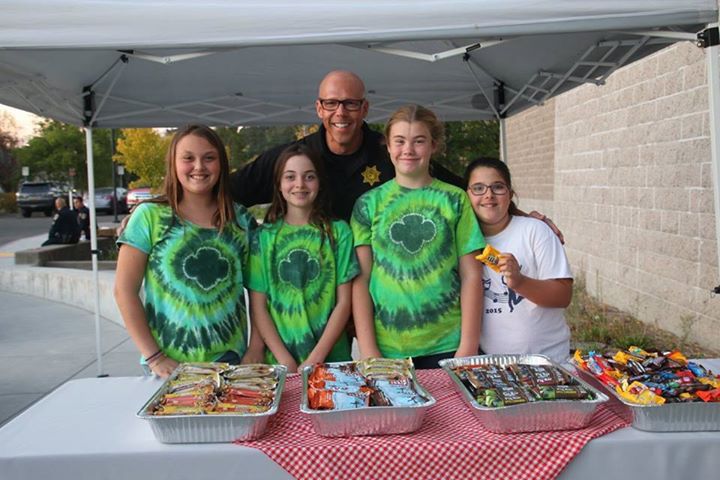In Girl Scouts we do a lot of projects that help our local communities, our cities, our counties, our state, even our nation, and our world. Some of these projects are considered community service while others are considered Take Action projects, and yet even more seem to fall into both categories at the same time. As a leader, a volunteer, or even a girl—how do you tell the two apart? How do you know if you are doing a project that would work for your Community Service Bar, or if you are doing a project that would qualify for a higher award, like the Silver Award?
Pin this post for later!
To some, this may seem like a very confusing topic, but never fear, help is here! In this blog post, I’ll break down both community service projects and Take Action projects, so you and your girls can better understand the difference between the two. First, let’s define two words that tend to be used interchangeably, “need” and “issue“. A “need” is something that is a condition requiring supply or relief. An “issue” is an important topic or problem that must be addressed on a bigger scale. Differences in these words elicit a different response from organizations. If you ask a homeless shelter what they “need”, you will normally get a response of physical items like blankets, towels, money, or pillows. If you ask a homeless shelter what “issues” they or the people they serve are facing, and you will get a response that goes beyond donations like linens can’t be washed at the shelters. So what do these words have to do with community service and Take Action projects?
Community Service Projects
Community service projects are projects that help to solve an immediate need, but they don’t impact the root cause of an issue. It’s just like Taylor Swift says in her song “Bad Blood”: “Band-aids don’t fix bullet holes”. Continuing to work with the homeless shelter example above, community service would be donating pillows—it’s an immediate need and a great thing to do, but it does not identify the root cause nor is the root cause affected. Once the shelter runs out of pillows they will be right back where they started.
Take Action Projects
Take Action projects are projects that help solve an issue by discovering the cause and developing a project to affect or eliminate the cause of the problem. Continuing with the homeless shelter example, a Take Action project would start by asking “but why can’t the shelter wash linens?” After a little research, you might learn that the shelter can’t wash linens because they don’t have a functioning washer or dryer to use. Without a washer and dryer the shelter ends up giving away used pillows, causing an ongoing need for new pillows. Speaking with the shelter you find out that they have an area where they could install a washer and dryer, but to meet their needs they would really need multiple industrial washers and dryers. They have not had these donated and cannot afford the cost of purchasing and hooking up. A Take Action project that would eliminate the root cause of the shelter’s linen washing problem may include working with local appliance companies to get a donated industrial washer and dryer installed, negotiating an ongoing donation of soap and dryer sheets from a local church, and creating a laundry storage area at the shelter. See how it’s different from a community service project?
Unlike community service projects, Take Action projects go a step further than collecting, making, and donating needed items. Community service projects stop when you stop, but Take Action projects do not; Take Action projects are continual, sustainable.
Another good example to help you recognize the difference between a community service project and a Take Action project is one focused on youth reading. A community service project would be to go to an organization like a library, school, or youth club and volunteer as a tutor. Once you stop tutoring, the organization will be in need of tutors again. A Take Action project would look more like noticing a youth club does not currently have a tutoring system in place therefore the children are not getting help with their homework at this organization. Then you could work with the organization to create a tutoring system from the ground up—custom designed for this organization, so it works for them. You might pull in a student club from a nearby school to create an ongoing supply of volunteer tutors for this organization. Then when you step away, this organization still has a tutoring system in place as well as volunteers that come to tutor.
Still with me? Here’s a handy chart to break it down:
| Community Service Project | Take Action Project |
|---|---|
| Addresses an immediate need in the community | Addresses the root cause of an issue in the community |
| A project done FOR the community | A project done WITH the community |
| A one-time project that helps something or someone now | A long-term project that is sustainable and makes a lasting impact |
There’s no doubt that both community service and Take Action projects make the world a better place. They just do so in different ways and at different levels. From Daisies to troop leaders and everyone in between, we all choose what we want to do to make our world a better place. And now that you know the difference between community service and Take Action, you can make informed decisions on what you want to accomplish. As our founder Juliette Gordon Low always said: “The work of today is the history of tomorrow and we are its makers.”
What to do next:
- Explore the different ways Girl Scouts give back through badges and Journeys. Take a look at the awards Girl Scouts can earn that help them build up skills so they can earn the Highest Award for their level the Bronze Award, the Silver Award, and the Gold Award!
- Is your girl thinking of going for her Bronze, Silver, or Gold Award? Check out this related read on how to help your girl find inspiration for her higher award project.
- Review the Take Action Projects section of Volunteer Essentials for more helpful information on the topic.
 Courtney Mierop—Courtney is the Program Coordinator, Older Girl Leadership and Awards for Girl Scouts of Northern California where she manages the system for the Highest Awards for all of Girl Scouts of Northern California’s 19 counties, as well as 5 volunteer committees, and programs for Older Girls. Courtney came to GSNorCal four years ago with a vast background in customer service and education, specifically youth based. Courtney has a Bachelor of Science in Justice Studies from San Jose State University.
Courtney Mierop—Courtney is the Program Coordinator, Older Girl Leadership and Awards for Girl Scouts of Northern California where she manages the system for the Highest Awards for all of Girl Scouts of Northern California’s 19 counties, as well as 5 volunteer committees, and programs for Older Girls. Courtney came to GSNorCal four years ago with a vast background in customer service and education, specifically youth based. Courtney has a Bachelor of Science in Justice Studies from San Jose State University.


This is a fantastic piece – thank you! I am a Gold Award mentor in Western PA, and I (we) see a lot of projects come through that need to bridge this gap. I’ll be sharing this with my mentees!
Those tie dye trefoils are adorable!
Thank you for writing this in a way that I, the troop leader, can understand. Businesslike statements don’t make sense to me or my girls, but this explains the difference between the two projects beautifully. I will share with all my girls.
I would the directions on those adorable shirts to try with my troop.
These tie dye trefoil shirts were made by a family friend who no longer makes them. Fortunately, we found a tie dye lady on ETSY that was able to make something similar! Her name is Theresa FOTI and her ETSY shop is Sunflower Tiedyes. Good luck!
These tie dye trefoil shirts were made by a family friend who no longer makes them. Fortunately, we found a tie dye lady on ETSY that was able to make something similar! Her name is Theresa FOTI and her ETSY shop is Sunflower Tiedyes. Good luck!